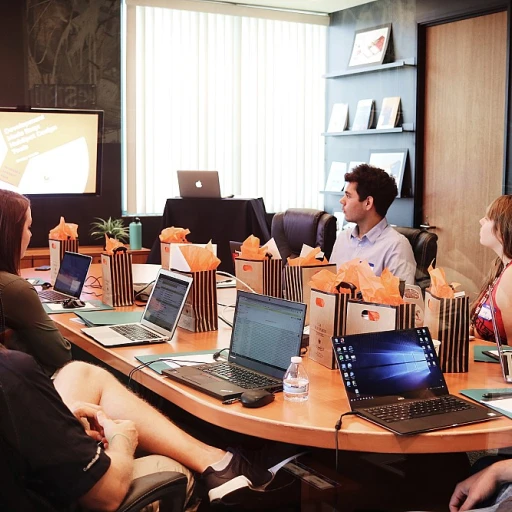Understanding Evolved HR
Unveiling Progressive HR Practices
In today’s fast-evolving business landscape, the role of human resources has significantly shifted from traditional personnel management to a more strategic approach in driving organizational success. This shift in HR practices has contributed profoundly to enhancing work-life balance for employees, making it an essential component of any forward-thinking company. The journey towards a more evolved HR practice starts with understanding how human resources function as a business partner rather than merely an administrative necessity. This transformation involves incorporating strategic talent acquisition and performance management systems that align with the needs of the employees while prioritizing organizational growth. By refining HR processes, businesses in the United States and beyond are able to attract and retain top talent, recognizing that employees are fundamental resources. This allows companies to foster a work environment where people’s well-being and job satisfaction are paramount, echoing the sentiments found in romantic poetry about human emotion and aspirations. Moreover, adopting a more contemporary approach to human resources management sees the integration of flexible work arrangements and employee well-being programs. These initiatives are crucial not only in shaping company culture but also in supporting the broader objective of organizational success. By sharing this evolved perspective on platforms like Facebook or through avenues such as Amazon books, businesses demonstrate leadership in their commitment to sophisticated HR strategies. For those looking to delve deeper into work-life balance opportunities, particularly in distinct environments like Kirkwood, exploring helpful resources can offer valuable insights. To further understand how evolved HR practices shape work-life balance, consider exploring employment opportunities in Kirkwood for comprehensive perspectives on integrating career growth with personal life priorities.The Role of Flexible Work Arrangements
Embracing Flexibility for Enhanced Work-Life Harmony
In today's dynamic work environment, the concept of flexible work arrangements is becoming a cornerstone of evolved HR practices. As companies strive to attract and retain top talent, offering flexibility is no longer just a perk—it's a strategic necessity. This shift reflects a deeper understanding of human needs and the complex interplay between professional and personal lives.
Flexible work arrangements can take various forms, from remote work options to flexible hours, and even compressed workweeks. These options empower employees to tailor their schedules in a way that accommodates their unique life circumstances, thereby enhancing their overall well-being and job satisfaction. For businesses, this flexibility can lead to increased productivity and a more engaged workforce.
Organizations that prioritize flexibility often witness a positive impact on company culture. By valuing employee autonomy, they foster an environment where people feel respected and trusted. This approach not only improves employee morale but also strengthens the emotional connection between the workforce and the company, contributing to long-term organizational success.
Moreover, flexibility in the workplace is not just about adjusting work hours. It involves a comprehensive approach to resource management, ensuring that all employees have access to the tools and support they need to thrive. This can include investing in technology that facilitates remote work, offering training programs to enhance digital skills, and implementing policies that support work-life balance.
For those seeking to explore employment opportunities that offer such flexibility, it's essential to research companies that prioritize these evolved HR practices. Exploring employment opportunities in Kirkwood can provide insights into how businesses are adapting to these changes and what potential employees can expect in terms of work-life balance initiatives.
In conclusion, flexible work arrangements are a critical component of modern HR strategies. They not only address the diverse needs of employees but also contribute to a more adaptive and resilient organizational framework. As businesses continue to evolve, embracing flexibility will be key to achieving sustainable success and fostering a supportive work culture.
Employee Well-being Programs
Promoting Employee Health and Happiness
Employee well-being programs are an essential component of evolved HR practices and play a vital role in promoting work-life balance within organizations. By prioritizing the health and happiness of employees, companies can not only enhance employee satisfaction but also improve overall organizational success. Businesses today acknowledge that their talent is their greatest asset. With strategic leadership, organizations are now investing in well-being initiatives. These programs focus on various aspects such as physical health, mental well-being, and financial security, ensuring comprehensive support for employees.- Physical Health: Companies often offer resources such as gym memberships, yoga classes, and health screenings to encourage a healthy lifestyle. This not only boosts employee morale but also reduces absenteeism.
- Mental Well-being: Recognizing the importance of mental health, forward-thinking organizations have introduced services such as counseling, mental health days, and stress management workshops. These initiatives help employees manage their workload more effectively, contributing to a harmonious work-life balance.
- Financial Security: Financial stress can severely impact an employee's performance. By providing financial planning resources, educational workshops, or even assistance programs, organizations demonstrate a commitment to their employees' holistic well-being.
Technology's Influence on Work-Life Balance
Technology as a Catalyst for Work-Life Harmony
In the modern landscape of human resources, technology plays a pivotal role in shaping how businesses approach work-life balance. With the advent of digital tools, companies are better equipped to support their employees in achieving a harmonious blend of work and personal life.
One of the most significant impacts of technology is the facilitation of remote work. This shift allows employees to manage their jobs from anywhere, providing the flexibility needed to accommodate personal commitments. As a result, businesses can retain top talent by offering a work environment that respects individual needs and preferences.
Enhancing Communication and Collaboration
Technology also enhances communication and collaboration among team members. Platforms like video conferencing tools and project management software enable employees to stay connected and productive, regardless of their physical location. This seamless integration of work and life activities fosters a sense of unity and belonging within the company culture.
Moreover, digital solutions help in tracking performance management, ensuring that employees are not overwhelmed by their responsibilities. By utilizing data-driven insights, human resource departments can tailor their strategies to meet the unique needs of their workforce, promoting overall well-being and organizational success.
Balancing Privacy and Connectivity
While technology offers numerous benefits, it is crucial to balance connectivity with privacy. Companies must establish clear boundaries to prevent employees from feeling perpetually "on-call." Implementing a comprehensive privacy policy and respecting personal time are essential components of evolved HR practices that prioritize human emotion and well-being.
As businesses continue to chase innovative solutions, the strategic integration of technology in human resources will undoubtedly enhance work-life balance. By leveraging these tools effectively, companies can create a supportive environment that values both professional and personal growth.
Creating a Supportive Work Culture
Fostering a Culture of Support and Understanding
In the quest for a harmonious work-life balance, the role of a supportive work culture cannot be overstated. A company that prioritizes the well-being of its employees is more likely to succeed in retaining talent and achieving organizational success. Businesses that have evolved their human resources practices understand the importance of nurturing a culture where people feel valued and understood.
To create such an environment, leadership must be proactive in their approach. Strategic management involves not just setting policies but also embodying the values they wish to see in their teams. By sharing insights and experiences, leaders can inspire a culture of openness and empathy. This approach aligns with the principles of performance management and resource management, ensuring that employees are not just seen as resources but as human beings with emotions and personal lives.
Encouraging Open Communication
Communication is the backbone of any supportive work culture. Encouraging employees to share their thoughts and concerns fosters a sense of belonging and trust. This is where human resources can play a pivotal role. As business partners, HR professionals should facilitate platforms where employees can express their needs and challenges without fear of repercussions. This transparency can lead to more effective talent acquisition and retention strategies, ensuring that the company remains competitive in the market.
Implementing Policies that Reflect Evolved HR Practices
Policies that reflect the evolved nature of HR practices are essential in supporting work-life balance. These include flexible work arrangements, employee well-being programs, and the strategic use of technology. By implementing such policies, companies demonstrate their commitment to the holistic development of their employees, which in turn enhances job satisfaction and productivity.
Ultimately, a supportive work culture is not just about policies but about the genuine care and respect that a company shows towards its employees. By prioritizing human emotions and needs, businesses can create an environment where employees thrive, leading to long-term success and stability.
Measuring Success in Work-Life Balance Initiatives
Assessing the Impact of Work-Life Balance Strategies
Measuring the success of work-life balance initiatives within a company is pivotal for both human resources and business leaders. These metrics not only provide insights into the effectiveness of implemented strategies but also guide future decision-making processes.
To evaluate the success of these initiatives, companies can focus on:
- Employee Satisfaction Surveys: Regularly conducting surveys can help identify how employees perceive their work-life balance. Their feedback directs the company's efforts towards better talent management and helps refine existing programs.
- Performance Management Metrics: Connecting work-life balance with employee performance is crucial. This can be achieved by tracking productivity and performance outcomes, which offers insights into whether new HR practices are enhancing organizational success or not.
- Retention and Turnover Rates: A supportive work culture often leads to reduced turnover rates. Monitoring these statistics can indicate if employees are satisfied with the work-life balance initiatives in place, potentially reducing hiring costs linked to resource business management.
- Feedback Loops: Encouraging employees to share their experiences and feedback on social platforms like Facebook can create a more dynamic resource management system, allowing businesses to adapt to changing needs.
- Strategic Leadership Reviews: Engaging in periodic reviews with leadership to assess the alignment of work-life programs with corporate goals ensures the strategic direction supports employee well-being.
Effective measurement of work-life balance initiatives promotes transparency within the company's culture. By keeping a keen eye on these metrics, human resources experts can continue to innovate and evolve HR practices, thereby maintaining a harmonious balance that caters to both organizational success and employee satisfaction.








